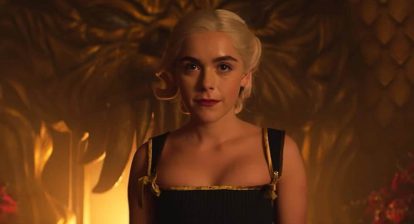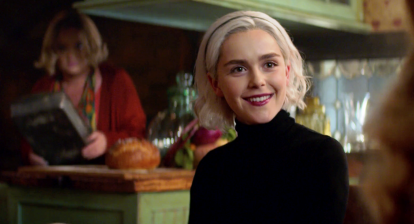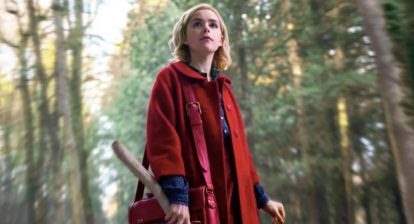We should probably be grateful Chilling Adventures of Sabrina is ending after just four seasons. If left to its own devices, the show could’ve jumped the shark like Riverdale did – although the argument could also be made that that show started things off by jumping the shark, and performing a musical interlude on top of it. CAOS, which is predominantly about a teenage witch fighting off demons and occasionally journeying to Hell to visit her father, who also happens to be Satan, is a more grounded show than Riverdale, which is wild considering. Maybe it’s easier to swallow the more bizarre elements because it’s a supernatural story. Or maybe Riverdale really is just that crazy. Either way, CAOS has always been the more grounded show and, in season 4, that kind of worked against it.
Related: Hail Satan! Chilling Adventures Of Sabrina Is A Devilishly Dark Delight
I’ve argued before that the weakest elements of CAOS were her boring-ass friends. Harvey is a dreamboat, but if he’s not going to end up with Sabrina, then who really cares what’s going on in his life? In season 4, the difficult relationship with his father is trotted out at random as though the writers forgot to give Harvey an arc. His relationship with Roz, meanwhile, is briefly interrupted by the news she’s (kind of) a witch before immediately getting back on track. Theo is still in love with that wood nymph or whatever and they, again, are briefly separated before being thrust back into each other’s arms to live happily ever after – that is, until he loses his powers by refusing to return to the other fairy folk but, hey, don’t think about that now! Young kids in love, right?
Sabrina is feeling left out this season and she tries to get her friends’ attention by faking a haunting, even though an actual supernatural invasion is happening just outside their doors. Season 4 is given a Monster of the Week style hook with the arrival of the eight Eldritch Terrors which, considering there are just eight episodes this time around, show up neatly and in polite single file. Unfortunately, this lumbers CAOS with an annoyingly episodic vibe, which would be fine if the whole thing hadn’t been dropped on Netflix simultaneously, necessitating a binge-watch. The Terrors themselves are fine, the first look like My Bloody Valentine’s masked miner killer and are dispatched rather easily, while others mess with time and space and one even takes the form of a homeless man.
In season 4’s standout episode, which is also its penultimate, Sabrina Morningstone travels to an alternate dimension where CAOS is being filmed except the original aunts from Sabrina the Teenage Witch are there instead. It’s a trip seeing Caroline Rhea and Beth Broderick back playing Hilda and Zelda again, and the two actresses are clearly having a ball. Salem, meanwhile, is portrayed by a purposely dodgy-looking animatronic cat that recalls Holliston’s Axel. He’s not voiced by Nick Bakay, sadly, but the Anglican intonations from Luke Cook (who plays Satan on the show, in a neat nod) are hilarious and watching Kiernan Shipka talking to a fake cat, especially while knowing she’s allergic to real ones and can’t share any scenes with the actual Salem as a result, is hugely entertaining.

Despite the many laughs, though, this is the season’s darkest episode overall. By adopting a meta take on the narrative, CAOS is given the freedom to be truly weird. Shipka quite literally wanders from set to set as she’s encouraged to learn her lines lest she end up in the dreaded “green room.” Although the episode ends predictably, it’s disconcerting and enjoyable enough to still represent a shining light of genuine oddity amidst a strangely grey season. Take Zelda’s relationship with Mambo Marie (Skye P. Marshall), which starts off hot and heavy but then is sidelined for much of the season until, at the end, it’s revealed that Marie is actually Baron Samedi because…there are no other famous voodoo practitioners? It’s a toothless reveal that robs the relationship of its queer energy. Likewise, Marie’s pairing throughout the season with Prudence (who continues to be a scene-stealer) and Roz speaks to deeper issues – perhaps more Black folks were required in the writers’ room? Or, on this evidence, any?
The biggest issue with CAOS throughout its run has been the sidelining of the most interesting characters in favor of the people we couldn’t really care less about, as with Sabrina’s milquetoast friends. A funny reference is made to Roz’s temporary blindness in episode 7, which seems to suggest the showrunners are at least aware of fan complaints, but it doesn’t explain why she then becomes a witch, out of nowhere, only for nothing much to come of that revelation. Roz doesn’t even struggle with her powers for a moment, effortlessly slotting into place with Sabrina’s coven. Likewise, the intolerable Nick Scratch continues to be a main character, first sporting with Prudence before dropping her to profess his love for Sabrina yet again because Prudence was just a bit of fun (eek). Although Harvey and Sabrina clearly aren’t OTP, not enough of a case is made for Nick as his replacement and it seems as though Sabrina ends up with him purely because she can’t stand to be alone (hence why she keeps her sort of twin around for so long, against the warnings of others).
See Also: Chilling Adventures of Sabrina: Season Two is a Total Hell-Send
Sabrina’s character has been criticized for being a bit vanilla but, in this season, Shipka is given the opportunity to show the protagonist’s more contradictory layers and rises to the occasion. This isn’t the Sabrina Spellman of Teenage Witch, who always got As and had her perfect boyfriend and didn’t let the mean girls get to her, this is a more believably teenage Sabrina, a petulant mess who can’t take it when she doesn’t get her way. In another standout episode this season, she meets a new guy but scares him off after succumbing to a Lovecraftian oceanic creature that makes her horny as all heaven, to use the show’s parlance, but also gives Sabrina a terrifying tentacular tongue, complete with suckers like an octopus. The visual effect is great, one of the show’s best, and it’s equally impressive because for once Sabrina is allowed to be (somewhat) ugly and weird.
When she’s perfect, the show grinds to a halt. Thankfully, there isn’t too much of that this season. Instead, everybody else behaves perfectly, which makes the first few episodes pass by in a blur as the monsters show up and are defeated without too much effort at all. Meanwhile, Father Blackwood, long one of the most fascinating elements of CAOS, is running a cult that takes in poor, easily led Ms. Wardwell (Michelle Gomez continues to effortlessly pull double duty). Curiously, this storyline doesn’t converge with the A story. The show ends with Wardwell reading from Blackwood’s self-penned bible and that’s kind of it. For a while, he exists only as a severed head on a platter, a nifty practical effect that must have been highly uncomfortable for actor Richard Coyle but looks terrific, but that’s the extent of his influence.

It makes sense, considering the witches have ousted him and now worship Hecate, but Blackwood is too compelling a character to see him defeated with so little fanfare. Even when he kidnaps Sabrina to use her for his own nefarious means, the focus is on her journey and that of her loved ones as they attempt a rescue, rather than on Blackwood’s dastardly machinations, which are revealed in passing. Considering what a key role he played in the previous three seasons, it seems crazy that Blackwood is such an afterthought in the big finale. Truthfully, he barely features at all. Satan gets even less of a look in this time around. It could be argued, of course, that this is by design because the women are now fully in control with the male characters as an afterthought. However, without a compelling antagonist, there isn’t much for the coven to do besides bicker among themselves – and they don’t even do much of that either.
CAOS has always purported to be about female empowerment. That Sabrina’s BFF this season is her other half, Sabrina Morningstone, further emphasizes the importance of female friendship. It’s puzzling, then, that the final image of the season and indeed the show itself is of Sabrina and Nick. Our plucky teen witch has never needed a man to give her life meaning, whether it’s a boyfriend or her father, to whom she refused to pledge her soul in the very first season. Why, then, does Sabrina end up sitting opposite Nick, a man she barely trusts, rather than reunited with Morningstone, who essentially gave her life up to save the coven, Sabrina, and the world? It’s a baffling choice, one that stings even worse when considering the series as a whole and raises serious questions about the Romeo & Juliet aping meaning behind it. CAOS has always worn its feminist bonafides proudly but by refusing to say goodbye to Sabrina without reassuring us she isn’t still single (Satan forbid), the show suggests that without a male companion her sacrifice is meaningless.
Related: Season 3 of Chilling Adventures of Sabrina is the Best Yet
CAOS is in a constant battle with the kind of show it wants to be and the kind of show it has to be in order to get over with YA viewers. Take, for instance, the truly ghastly Battle of the Bands episode, which somehow manages to be more cringe-worthy than when Sabrina and the cheerleaders performed a routine to a Run-DMC song last season. As drag queen and Drag Race alum Ben DeLaCreme pointed out on Twitter at the time, there’s plenty of outlandish stuff we have to swallow to enjoy this messy little show but, when it comes to musical moments like this, it’s impossible not to roll your eyes all the way back. The Fright Club is performing against a group of zombie punks who also seem to be metalheads, judging by the descriptions of others, but play neither punk nor metal music (note to showrunners, if you’re going to reference Return of the Living Dead, make sure you understand what that movie is actually about first). Sabrina doesn’t even perform with the Fright Club at the show, rather she covers “Sweet Child O’ Mine” because apparently her own rag-tag band are more used to playing weddings.
The Fright Club, on the other hand, does a rendition of the “Time Warp” that’s so insultingly terrible – complete with dodgy accents and all – it’s a wonder Richard O’Brien even signed off on it. Although, considering nobody in the scene appears to be actually doing the “Time Warp,” and the instructions aren’t even sung as normal, maybe he didn’t. Aside from Ross Lynch, an accomplished musician in real life, none of these actors are particularly strong singers or live performers. Moments like this just remind us that they’re all weird song-and-dance kids who grew up either watching Disney or even working for them. We don’t need Shipka attempting to belt it out to understand how committed Sabrina is to saving Greendale. She’s doing just fine playing her role here. CAOS is at its weakest when it tries to be another Riverdale, especially considering there’s enough genuinely strange stuff already inherent to the show that it doesn’t need to do anything extra.
There’s still plenty to enjoy about the season of course, from the reliably strong performances – particularly from the older actors, once again – to the dry and resolutely dark humor, the impeccable styling and the well-drawn nightmare worlds the various characters inhabit (more time in Hell wouldn’t have gone awry). What a shame, then, that CAOS ends on such a bum note, its inevitability as a kind of superhero origin story laid bare and betraying the show’s previous commitment to anarchic, fiercely feminist content.





